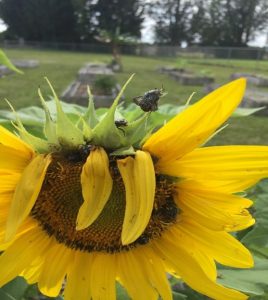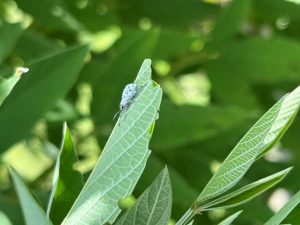Pests are everywhere. They will eat your seedlings, munch the leaves, bore into the fruit you’ve been watching ripen for weeks. The temptation to “just spray them away” is common, but often the results are worse than if you did nothing. Some pests are resistant to the chemicals we use, and many chemicals are just as deadly to the pollinators and predators which are beneficial to our gardens.
Integrated pest management, or IPM, is a comprehensive approach to managing plant pests. IPM relies on various methods that cause the least harm to people, property, and the environment. IPM’s emphasis is on the management of problems, rather than their eradication. Correct identification of the pest is also important to manage properly.
A healthy plant in the right environment will be less stressed and able to better handle pests than one struggling in a poor habitat. Proper watering and fertilizing also keep plants from other stresses in the garden. There are also pest and disease resistant varieties we can use to help avoid pest problems, and by regularly rotating where we grow certain veggies we can minimize the damage of soil-borne issues. These types of “Cultural” practices consider pest management even before a garden is planted.
Another cultural method is to encourage beneficial predators to feed on the pests. Companion planting with “insectary” plants attract pest predators such as ladybugs, lacewings, and hoverflies. Many herbs serve as attractants, while rosemary and garlic have scents that seem to deter pests as well. “Trap plants” such as nasturtiums and sunflowers can lure pests away from vegetable crops. Planting these companions are a great way to manage pests while adding colorful herbs and flowers to your garden.
Physical methods of pest management is the least harmful for plants and the environment. Hand removal of the pest or blasting them off with a jet of water are simple yet effective ways of getting rid of many pests. Netting can also keep pests away from crops, yet some nets can prevent pollinators from getting in as well.
It is important to monitor crops frequently, as pests can show up at any time, and return after they’ve been removed.
If chemical methods are needed for pest management, always start with low-impact products least harmful to our environment and follow all directions on the labels. Some of these include:
- Plant extracts such as pyrethrin and neem oil
- Microbial products (BT, spinosad…) which are derived from bacteria
- Horticultural soaps are effective, but can also affect beneficial insects and pollinators, and can damage the plant if applied improperly
- Species specific pesticides only harm those intended when used properly (slug and snail baits)
Follow all directions, spot treat and continue monitoring for issues
You can read the full UF/IFAS blog article “Using Insectary Plants to Attract Pest Predators” linked below:
Chafer Beetles on sunflower

Sri Lankan Weevil


